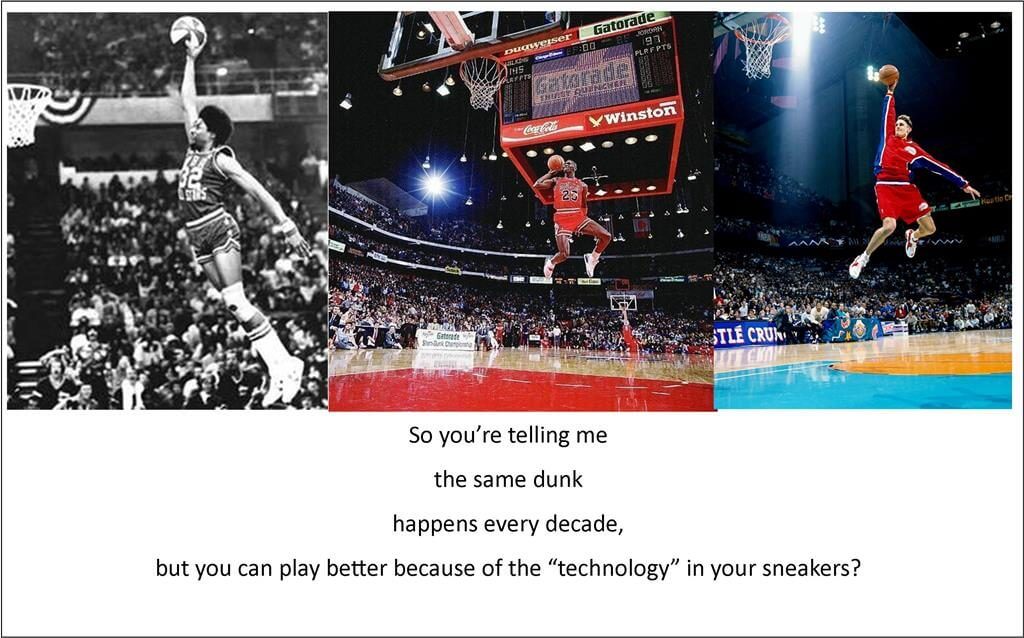![]()
Source: adidas NEWS STREAM : adidas’ BOOST technology powers Aberu Kebede to victory in Berlin
Above is a post from adidas about one of their sponsored runners winning a marathon.
If you visit any sports company’s website you will find a celebration of the athlete and how their gear inspired them and helped them to perform a certain way. This marketing is done to convince the everyday athlete that they can accomplish the same incredible feat by wearing a pair of Air Jordans, or adidas BOOST technology. The industry relies on the desire for people to be “like Mike” or to understand that “Impossible is Nothing”.
The honest truth once we dig into the narrative becomes really interesting.

In the picture to the left is Weldon Kirui winning the LA Marathon in Skechers. He is running in a shoe named after one of the greatest current distance runners, Meb Keflezighi, the GoMeb 3. Nike would have you believe that Nike Flywire and Nike Zoom Air is the training tool needed to be as fast as Usain Bolt. The problem is Usain Bolt wears Puma’s Ignite to train in. What becomes a lot more interesting is that the shoes that the fastest people in the world wear, are barely even shoes at all. Runners use racing flats. The shoes are often seamless, one piece uppers attached to the an PU midsole with track spikes. The runner uses this minimalist shoe because the best way for the foot to perform is when it has as much contact with the ground as possible allowing the tendons and toes to splay at and create a launching like motion using the calf muscle, glutes and hamstrings. In other words, the fastest people in the world don’t require Boost, or additional cushioning because their bodies are trained to perform at the highest levels.
What do I mean by misleading then? What sneaker companies don’t want to market to you is the aspect of training smarter and better to improve your skill level. Does technology work? Yes and No. if you have a person who weighs too much and they want to start training to run, this person will require a shoe that is considered a stability shoe. These shoes help to prevent pronation issues and the potential for injury due to the weight of a person. Research is begining to confirm what has always been true, barefoot or minimalist footwear may improve your strength overall. Sneaker technology does help to support the foot when an athlete is playing a sport that requires considerable torque. Basketball for example is a sport that requires the foot to perform with a lot of explosive movements. A high top shoe can prevent a player from rolling an ankle, but research also shows that most rolled ankles occur due to landing on another players foot, slipping, or incorrect placement on the floor while running. Unfortunately there isn’t a shoe designed that can minimize the damage of any of these actions. The only thing that stops the injury in this case is the players flexibility. Take the following picture for instance:
Dr. J played basketball at a very high level. He literally changed the game along with Connie Hawkins. Michael Jordan also reinvented the game. Brent Barry… not so much, but they all performed the same dunk during their careers: a jump from the free throw line. I have to ask if Dr. J wore Nike shoes with Zoom Air and Flywire, would he have been able to jump from the top of the key? Probably not.
Why is there an emphasis on the technology when we know that it really does very little to improve performance? Marketing. Aesthetically new shoes look good and feel good. Placebos have real value. When Nike says that their shoes will make you fly higher, they actually can make you fly higher because the shoes may move you beyond a mental block. Personally I started my shoe company because the only shoe that I could run in for a while was the Puma FAAS and I got tired of tracking the shoe down so I made my own. I wanted a shoe that was primarily foam because shoes that had higher heels and weren’t zero drop made my knees hurt. When I say “Misleading” I mean that yes shoes with technology do have an effect. That effect is a bad one primarily because most shoes are made based on style and tend to have shapes that remove the ability for the foot to perform as they should. The next time you look at an athlete and say oh his shoes are bad, take a few things into consideration:
- How long has that player been involved in that sport. People dissed Derrick Rose’s shoes. Derrick Rose did not cross train. He has played basketball since he was 10. The games he played on average AAU and school total up to around 60 games a year with practices. His body is breaking down. It’s not the shoes. Take LeBron for instance who is bigger and stronger. LeBron played more than one sport and cross trained. He isn’t breaking down because he understands the benefit of training different parts of the body. The guy actually bikes to practice on occasion. Repetition leads to injury.
- Look at the shoes. If the shoes have a bulky heel and a lot of separation from the floor, most injuries are caused in those shoes in all sports.
- Look at the size and weight of the player and how explosive they are. If a player is heavy and explosive they will have injuries. If a player is short and plays below the rim their injuries will come from contact. It doesn’t matter what the size a player is, if their footwear creates too much distance from the floor they will be injured more often than a player who ha footwear closer to the floor. Consider the amount of injuries in all sports increased as more cushioned shoes were introduced that had elevated heels.
I guess this is a long post that basically says one thing, don’t believe the hype. Wear what you like.






